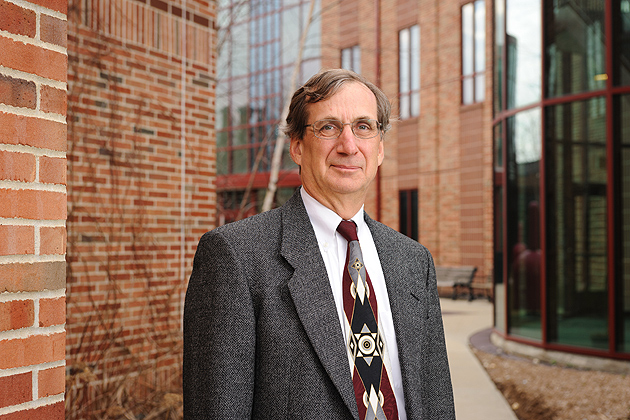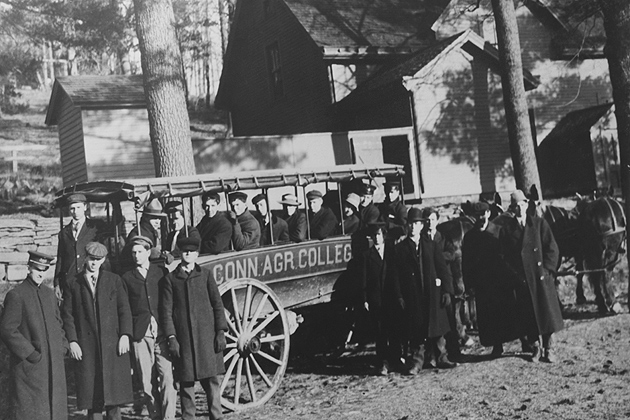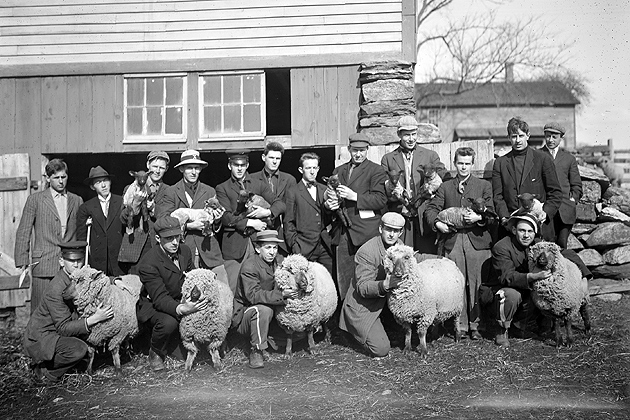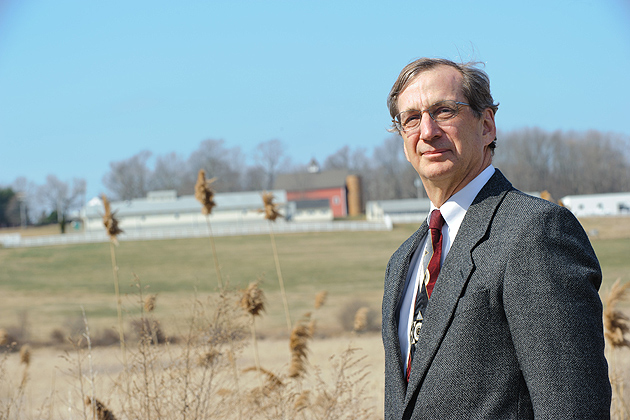
The College of Agriculture and Natural Resources is not the ‘Ag School’ of our (great-) grand-parents’ day. While a focus on family farming and ‘mechanical arts’ was appropriate 150 years ago when the Morrill Act of 1862 created the land-grant system of education, the founders of the University of Connecticut’s antecedent institutions – the Storrs Agricultural School and the Connecticut Agricultural College – could not have envisioned the variety of courses and majors offered in the name of agriculture and natural resources today.
In recognition of the 150th anniversary of the Morrill Act this year, which will be officially observed in July, Dean Gregory Weidemann sat down with UConn Today to take a look at the past, and to comment on some future goals.

Q The Morrill Act of 1862 was created to establish institutions in each state that would educate people in agriculture, home economics, mechanical arts, and other professions that had a practical application at the time. Why was that important?
A The Morrill Act was really a ground-breaking piece of legislation. Up until the time it was passed, higher education in the United States was based on the liberal arts and really intended for the upper class. The Morrill Act established an educational system that fit the needs of the average person, and it provided training that really moved us into the industrial age. If you look at the history of this college [The College of Agriculture and Natural Resources], you can see that it has followed the evolution of the needs of the state of Connecticut.
When you think about the 1860s, most people still lived in rural areas and agriculture was their focus; but as things changed after the Civil War, our society became more industrialized and there was an increasing need for training in the ‘mechanical sciences’ … which translates into engineering … as well as maintaining a healthy agricultural system.
Today, most of the Ph.D.’s in the sciences come from land grant universities. Both here at UConn and across the nation, schools that started out focusing on agriculture gradually transformed into these great multi-disciplinary institutions that we have today.

Q So it wasn’t just a static piece of legislation …
A Not at all. The Smith-Lever Act of 1914 is a good example. It established cooperative extension as a partnership of the U.S. Department of Agriculture and the land-grant universities. Supporters of the bill felt information gathered by scientific research should be shared with local farmers, who could benefit more from a demonstration by an agent who knew the work and could apply the research than from reading bulletins and pamphlets. That’s how our Department of Extension grew, and that’s why it’s a valuable asset to our citizens today.
From the Center for Land Use Education & Research (CLEAR), to programs involving food safety and nutrition, to forestry management, and 4-H … we reach thousands of Connecticut’s citizens on an annual basis.
Q When we think ‘agriculture,’ Connecticut probably isn’t the first state that comes to mind. Where do agriculture and natural resources fit into the scheme of things at UConn?
A I’ve been at UConn for almost four years, and one of the reasons I wanted to come here is that the College of Agriculture and Natural Resources hadn’t been static. As the needs of the state had changed, the programming here had changed, both in basic research and by good decision-making on urban, suburban, and rural interface issues.
I think that we’re at a special time in Connecticut history. The average citizen in this state seems to have a great recognition and appreciation of agriculture. Connecticut has become an example of people going in full circle and really understanding the importance of agriculture for its aesthetic value and for its value as an economic driver. As populated as this part of the country is, this is a state that hasn’t been covered in concrete, and people appreciate a semi-rural lifestyle. Contrary to what you see in many parts of the country, the number of farms and farm acres in Connecticut is actually going up, and that gives us a great opportunity to develop a more integrated local food system … and that benefits everyone.

Q As a land grant university, UConn has deep roots in the state’s economy, but you’re definitely not standing still.
A That’s true. The fact is, the United States has the most efficient agricultural system in the world, and people want to learn from us and improve their own situations. Here in the College of Agriculture and Natural Resources, we also recognize that we have some responsibility to help extend our technology to the world community, so we’ve looked at some strategic partnerships that will not only benefit our foreign partners, but UConn and Connecticut as well. We’re looking for a good marriage, where both members of the collaboration bring their best people to the table so it’s a win-win situation.
Most recently, we have focused on establishing relationships with universities in China. Their economy continues to grow, but they also have some food and natural resources challenges where we could be helpful. We’ve visited a number of institutions, and we are going to focus on a couple that seem like natural partners for us.
This summer we will have a study abroad program focusing on the environment and agriculture of China. Students will visit three of the top universities in Beijing, Chengdu, and Yangling, and they’ll take field trips into the countryside, where they can study biodiversity, agricultural management and economics, rural development, and other issues that are critical in a developing nation.
There’s also considerable interest on the part of the Chinese to send their students over here for graduate training, so the benefits of this exchange will reach in both directions. Our intent isn’t to rush into anything; we are working on gradually building relationships and establishing a few deep partnerships.
Q Any final words about research projects and programs where CANR particularly shines?
A It is always difficult to select a few examples from among more than 300 individual projects and programs conducted by our faculty members. Perhaps these three examples might serve to show how our programs impact economic development in Connecticut.
In 2009, the state legislature established an agricultural sustainability account to provide financial assistance to dairy producers when milk prices fell below the monthly cost of production. The Commissioner of Agriculture requested that the Zwick Center for Food and Resource Policy in the Department of Agricultural and Resource Economics provide cost of production information based on estimates for New England previously provided by USDA. The department has continued to provide quarterly estimates, while preparing for a full study of Connecticut costs of production based exclusively on Connecticut-based dairy farms.
Burning Bush is a popular ornamental shrub in the Connecticut landscape. Unfortunately, the plant’s prolific seed production has caused it to be considered invasive in many New England states. Dr. Li in the Department of Plant Science and Landscape Architecture has developed a seedless variety of Burning Bush that, once released, will allow this plant to be retained by the ornamental industry, saving millions in lost revenues.
The Center of Land Use and Education uses remote sensing and geographic Information systems to guide informed decision-making by land use planners. This program has worked in nearly every Connecticut town and trained hundreds of municipal officials on sustainable land use.



